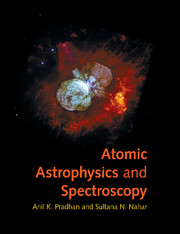Book contents
- Frontmatter
- Contents
- Preface
- Acknowledgements
- 1 Introduction
- 2 Atomic structure
- 3 Atomic processes
- 4 Radiative transitions
- 5 Electron–ion collisions
- 6 Photoionization
- 7 Electron–ion recombination
- 8 Multi-wavelength emission spectra
- 9 Absorption lines and radiative transfer
- 10 Stellar properties and spectra
- 11 Opacity and radiative forces
- 12 Gaseous nebulae and H II regions
- 13 Active galactic nuclei and quasars
- 14 Cosmology
- Appendix A Periodic table
- Appendix B Physical constants
- Appendix C Angular algebra and generalized radiative transitions
- Appendix D Coefficients of the fine structure components of an LS multiplet
- Appendix E Effective collision strengths and A-values
- References
- Index
13 - Active galactic nuclei and quasars
Published online by Cambridge University Press: 05 June 2012
- Frontmatter
- Contents
- Preface
- Acknowledgements
- 1 Introduction
- 2 Atomic structure
- 3 Atomic processes
- 4 Radiative transitions
- 5 Electron–ion collisions
- 6 Photoionization
- 7 Electron–ion recombination
- 8 Multi-wavelength emission spectra
- 9 Absorption lines and radiative transfer
- 10 Stellar properties and spectra
- 11 Opacity and radiative forces
- 12 Gaseous nebulae and H II regions
- 13 Active galactic nuclei and quasars
- 14 Cosmology
- Appendix A Periodic table
- Appendix B Physical constants
- Appendix C Angular algebra and generalized radiative transitions
- Appendix D Coefficients of the fine structure components of an LS multiplet
- Appendix E Effective collision strengths and A-values
- References
- Index
Summary
The number of stars in a galaxy varies over a wide range. Whereas dwarf galaxies may contain as ‘few’ as ~107 stars, giant galaxies at the other end of the numerical stellar count are five orders of magnitude higher, into trillions of stars ~1012. Our own Milky Way is a collection of about 100 billion ~1011 stars, which we may take to be the number in a ‘normal’ galaxy. Given the luminosity of the Sun as the benchmark L⊙ = 3.8 × 1033 erg s-1, the luminosity of a normal galaxy LG ~ 1044 erg s-1. Large as that number is, it turns out that a good fraction of galaxies, at least 10%, are much brighter. To be a bit more precise, the central regions of such galaxies are extremely bright, with central luminosity at least equal to that of the rest of the galaxy. At first sight, this might not seem illogical, given the expectation of a greater concentration of stellar systems towards the centre of a galaxy. However, these ultrabright central regions exhibit a number of outstanding observational facts.
(i) The emergent luminosity can be extremely intense with a range of 1012-15L⊙, or more than 10,000 times the luminosity of an entire galaxy LG.
(ii) The central source is highly concentrated in an extremely small volume of a small fraction of a parsec (pc), on the spatial scale of no more than our solar system, whereas the galaxy itself may be tens of kpc.
[…]
Information
- Type
- Chapter
- Information
- Atomic Astrophysics and Spectroscopy , pp. 278 - 304Publisher: Cambridge University PressPrint publication year: 2011
